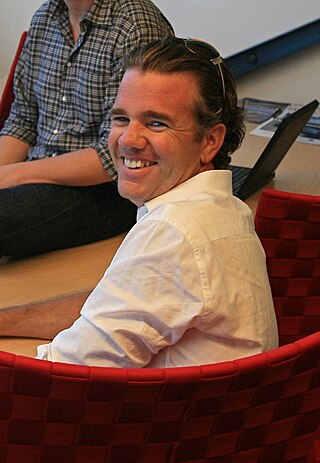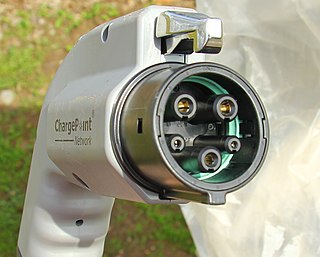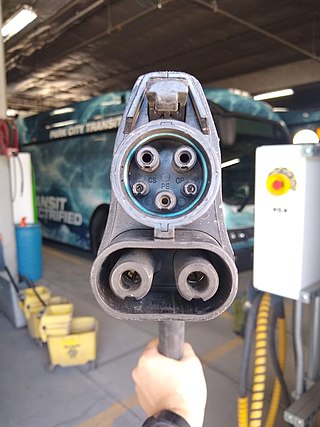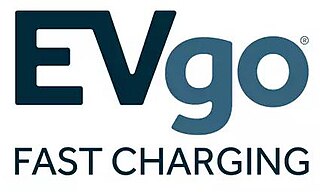Related Research Articles

Franz von Holzhausen is an American vehicle designer. Since 2008, he has been in charge of design at Tesla, Inc. He led design for the Tesla Model S, Model 3, Model X, Model Y, Semi, Cybertruck and Tesla Roadster. Prior to Tesla, he worked in design at Mazda, General Motors, and Volkswagen.

A charging station, also known as a charge point, chargepoint, or electric vehicle supply equipment (EVSE), is a power supply device that supplies electrical power for recharging plug-in electric vehicles.

An electric car or electric vehicle (EV) is a passenger automobile that is propelled by an electric traction motor, using only energy stored in on-board batteries. Compared to conventional internal combustion engine (ICE) vehicles, electric cars are quieter, more responsive, have superior energy conversion efficiency and no exhaust emissions and lower overall vehicle emissions. The term "electric car" normally refers to plug-in electric vehicle, typically a battery electric vehicle (BEV), but broadly may also include plug-in hybrid electric vehicle (PHEV), range-extended electric vehicle (REEV) and fuel cell electric vehicle (FCEV).

An electric vehicle charging network is an infrastructure system of charging stations to recharge electric vehicles. The term electric vehicle infrastructure (EVI) may refer to charging stations in general or the network of charging stations across a nation or region. The proliferation of charging stations can be driven by charging station providers or government investment, and is a key influence on consumer behaviour in the transition from internal combustion engine vehicles to electric vehicles. While charging network vendors have in the past offered proprietary solutions limited to specific manufacturers, vendors now usually supply energy to electric vehicles regardless of manufacturer.

SAE J1772, also known as a J plug or Type 1 connector after its international standard, IEC 62196 Type 1, is a North American standard for electrical connectors for electric vehicles maintained by SAE International under the formal title "SAE Surface Vehicle Recommended Practice J1772, SAE Electric Vehicle Conductive Charge Coupler".

CHAdeMO is a fast-charging system for battery electric vehicles, developed in 2010 by the CHAdeMO Association, formed by the Tokyo Electric Power Company and five major Japanese automakers. The name is an abbreviation of "CHArge de MOve" and is derived from the Japanese phrase "o CHA deMO ikaga desuka" (お茶でもいかがですか), translating to English as "How about a cup of tea?", referring to the time it would take to charge a car.

Tesla Supercharger is an electric vehicle DC fast-charging network built by American vehicle manufacturer Tesla, Inc.

The Combined Charging System (CCS) is a standard for charging electric vehicles. It can use Combo 1 (CCS1) or Combo 2 (CCS2) connectors to provide power at up to 350 kilowatts (kW) . These two connectors are extensions of the IEC 62196 Type 1 and Type 2 connectors, with two additional direct current (DC) contacts to allow high-power DC fast charging. In response to demand for faster charging, 400 kW CCS chargers have been deployed by charging networks and 700 kW CCS chargers have been demonstrated.

EVgo Inc. is an electric vehicle DC fast charging station network in the United States, with more than 950 charging locations as of August 2023. The company's charge stations are located in 35 states and are compatible with all major auto manufacturers.
Fisker Inc. is an American automotive company founded by Danish automotive designer Henrik Fisker and his wife Geeta Gupta-Fisker.
Contemporary Amperex Technology Co., Limited, abbreviated as CATL, is a Chinese battery manufacturer and technology company founded in 2011 that specializes in the manufacturing of lithium-ion batteries for electric vehicles and energy storage systems, as well as battery management systems (BMS). The company is a major EV battery manufacturer, with a global market share of around 37% in 2023.

ISO 15118Road vehicles -- Vehicle to grid communication interface is a proposed international standard defining a vehicle to grid (V2G) communication interface for bi-directional charging/discharging of electric vehicles. The standard provides multiple use cases like secure communication, smart charging and the Plug & Charge feature used by some electric vehicle networks.

The adoption of plug-in electric vehicles in Australia is driven mostly by state-based electric vehicle targets and monetary incentives to support the adoption and deployment of low- or zero-emission vehicles. The monetary incentives include electric vehicle subsidies, interest-free loans, registration exemptions, stamp duty exemptions, the luxury car tax exemption and discounted parking for both private and commercial purchases. The Clean Energy Finance Corporation, energy providers, car loan providers and car insurance providers also offer their own financial incentives for electric vehicle purchases including Macquarie Bank offering the lowest electric car loan of 2.99%.
Ionity is a high-power charging station network for electric vehicles to facilitate long-distance travel across Europe. It's a joint venture founded by the BMW Group, Mercedes-Benz Group, Ford Motor Company and Volkswagen Group, but other automotive manufacturers are invited to help expand the network. In November 2020 Hyundai Motor Group entered Ionity as the 5th shareholder. Ionity enables roaming from electric mobility service providers (EMSP's).

Electrify America, LLC is electric vehicle DC fast-charging network in the United States, with more than 900 stations and over 4,000 DC fast charging connectors as of December 2023. It is a subsidiary of Volkswagen Group of America, established in late 2016 by the automaker as part of its efforts to offset emissions in the wake of the Volkswagen emissions scandal. Volkswagen, as part of its settlement following the "Dieselgate" emissions scandal, invested $2 billion in creating Electrify America. In June 2022, Siemens became a minority shareholder of the company. Electrify America supports the CCS and CHAdeMO connector types with plans to add NACS connectors starting in 2025. Electrify America has been the target of significant criticism for the perceived lack of reliability and maintenance of its stations.

The Tesla Cybertruck is a battery electric medium duty full-size pickup truck built by Tesla, Inc. since 2023. Introduced as a concept vehicle in November 2019, it has a body design reminiscent of low-polygon modelling, consisting of flat stainless steel sheet panels.

The Ford Mustang Mach-E is a battery electric compact crossover SUV produced by Ford. Introduced on November 17, 2019, it went on sale in December 2020 as a 2021 model. The Mach-E is part of the Mustang series, with its name inspired by the Mach 1 variant of the first-generation Mustang. The car won the 2021 North American SUV of the Year Award.

Electrify Canada is a corporation formed by Electrify America and Volkswagen Group to build electric vehicle (EV) direct current (DC) charging infrastructure in Canada.

The adoption of plug-in electric vehicles in Iceland is the second highest in the world after Norway, and fully supported by the government. As of 2022, the market share of electric vehicles in Iceland is around 60%, the second-highest in the world behind Norway. Around 14% of the country's passenger car fleet is electrified as of 2022.

The North American Charging System (NACS), being standardized as SAE J3400, is an electric vehicle (EV) charging connector system developed by Tesla, Inc. It has been used by all North American market Tesla vehicles since 2021 and was opened for use by other manufacturers in November 2022. It is backwards compatible with the proprietary Tesla connectors made before 2021.
References
- 1 2 "High-Powered EV Charging Network, IONNA, Begins Operations in North America". Ionna LLC. 2024-02-24.
- ↑ Sam Abuelsamid (2024-02-09). "Automaker EV Charging Network Branded Ionna, Seth Cutler Named CEO". Forbes.
Several of the members of this group are already part of a similar joint venture in Europe called Ionity that has been operational for several years
- ↑ Iris Martinz (21 December 2021). "Weißes Haus stellt Plan zum Ausbau des E-Ladenetzes vor" (in German). Elektroauto News.
- ↑ Michael Neißendorfer (9 June 2023). "General Motors bindet Tesla Supercharger ein und setzt auf NACS statt CCS" (in German). Elektroauto News.
- ↑ "Volkswagen, Audi, Porsche and Scout Motors brands to implement the North American Charging Standard in future electric vehicles". Volkswagen AG . 2023-12-19. Retrieved 2023-12-22.
- ↑ Sebastian Schaal (2024-02-12). "Autobauer-Allianz bringt US-Ladenetz als Ionna an den Start". Electrive.net.
- ↑ Luca Leicht (2023-07-27). "Mehr als doppelt so viele Schnelllader wie Tesla". auto-motor-sport.
- ↑ Graham Jarvis (2024-05-29). "IONNA Superchargers to Miss Summer Targets". Wards Auto.
- ↑ Fred Lambert (2023-11-30). "Tesla's charging network is not ready for Cybertruck". Electrek.
- ↑ Daniel Zlatev (2023-12-02). "Cybertruck charge time is 20 minutes at 350kW V4 Supercharger as Tesla splits the battery in 400V units" (in German). NotebookCheck.
Notes:
- ↑ The company register in Oregon shows a foundation in December 2005. The shell corporation was probably bought between July and February. The 9th of February points to the allowance for operation as a charging network.
- ↑ Mercedes, BMW and Hyundai are also founding members of Ionity
- ↑ availability over 99% and defunct charging points were shown correctly in the app
- ↑ specifically the charging cards were failing often
- ↑ the Electrify America charging sites are usually located on mall areas in the suburbs